Big Game Hunting Season is Not Over Yet
Even though we’re in the height of turkey season, there is still plenty of big game to be had—in Texas!
by HEIDI LYN RAO posted on March 21, 2023
Support NRA Women DONATE
Do not put those hunting rifles away just yet; come on down to Texas! Check your local rules and regulations. In Texas, exotic animals can be hunted with a valid hunting license, year round, and with permission granted by the landowner. Texas is home to more free-ranging exotic animals than any other state in the union. This includes species such as red stag, gemsbok, sambar deer, and a host of other animals. Some of these animals, like the scimitar oryx, cannot even be hunted in their native country. Texas is much more convenient and less expensive than traveling to Africa!
Some of the exotics are even hard to find in Texas, but with a little research you can find what you are looking for. On the other hand, there are some species of exotics that are quite common. In some areas, exotics even outnumber white-tailed deer. There are several species of exotics commonly hunted in Texas. These include axis deer, sika deer, fallow deer, blackbuck antelope, nilgai antelope, aoudad sheep and Corsican sheep. An exotic trophy might be just the thing to add to your game room!
DEER
Axis Deer (Axis Axis)
Axis deer, called Chital in their native Southeast Asia, have a rusty orange upper coat covered in bright spots. Both bucks and does have white throat patches when they are mature. The bucks have tall antlers with an average of 3 points per side. Axis deer have an average antler length of 22 inches to 27 inches while trophy bucks have an average antler length of 30 inches to 36 inches.
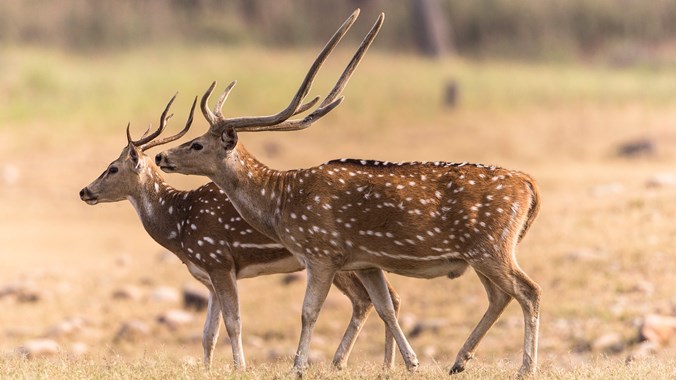
Axis deer are heavy-bodied deer. Mature does have a mature body size of 90 lbs. to 150 lbs. and stand between 28 inches and 32 inches tall. Mature bucks attain a weight between 150 lbs. to 250 lbs. and stand between 35 inches and 40 inches tall. Axis deer have been introduced in several states including Texas, Mississippi, Alabama, California and Hawaii.
Sika Deer (Cervus Nippon)
Sika deer are native to Japan and the eastern region of the Far East. Because of its introduction, this species can now be found throughout South and West Texas. Sika deer are a small- to medium-size deer standing approximately 20 inches to 44 inches. Bucks weigh between 90 lbs. and 175 lbs., and does weigh between 55 lbs. and 120 lbs. The subspecies, Manchurian Sika deer, are the largest. Manchurian sika bucks can weigh up to 250 lbs. while the does can weigh up to 150 lbs.
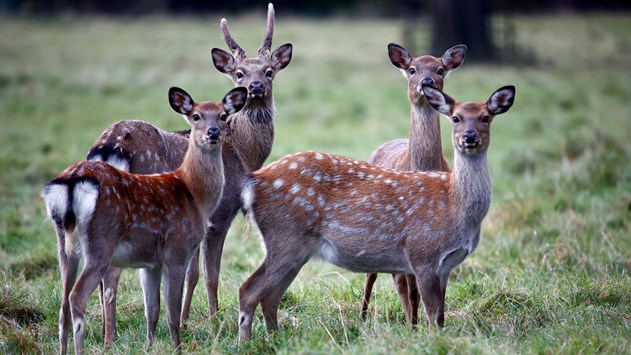
The coloration of sika deer ranges from a drab brown to a deep mahogany brown mottled with numerous white spots, similar to axis deer. Bucks have antlers and does have a pair of black bumps on their forehead where antlers would normally be. Antlers average 18 inches to 26 inches long while trophy bucks can have antlers over 30 inches.
Fallow Deer (Dama dama)
Fallow deer are native to India, Pakistan and Nepal. Fallow deer are medium-sized animals standing approximately 33 inches to 40 inches. Bucks weigh between 130 lbs. and 225 lbs.; does weigh between 30 lbs. and 35 lbs. and stand 33 inches to 35 inches at the shoulder. The fallow deer prefer wooded areas with open areas in between.
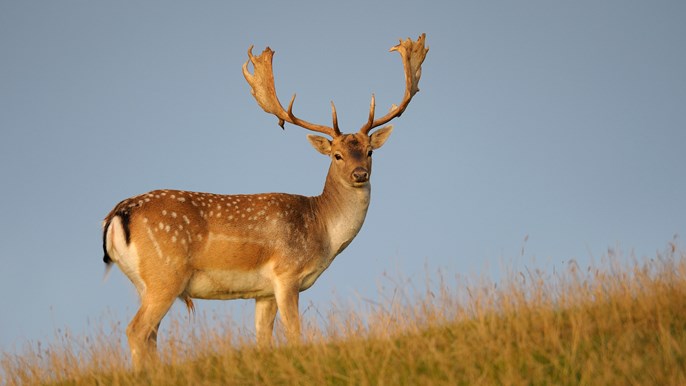
The coloration of fallow deer ranges from white, brown, black, to chestnut with white spots and lighter color underneath. Bucks have antlers that are palmate, or shovel-like, similar to moose antlers. The antlers of fallow deer range on average from 18 inches to 24 inches, with trophy antlers reaching 24 inches to 36 inches, or more.
ANTELOPE
Black Buck Antelope (Antilope cervicapra)
Black Buck Antelope are native to India, Pakistan and Nepal. Blackbuck antelopes are small-sized animals standing approximately 28 inches to 36 inches. Bucks weigh between 45 lbs. and 130 lbs.; does weigh between 45 lbs. and 75 lbs. The blackbuck antelope prefers grasslands or slightly forested open country.
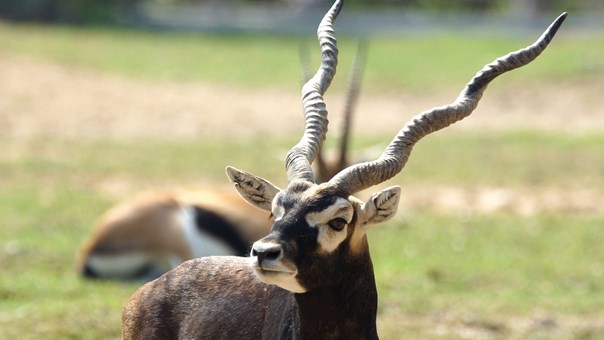
The coloration of blackbuck antelope bucks is striking and ranges from a drab brown to a deep black on the upper body, and bright white underneath. The face is dark brown to black with eyes circled in white and white muzzle. Bucks normally get darker as they age. Does are a light to dark brown on their upper body with similar white area underneath and on the face. Bucks have ringed, spiral horns that angle straight backwards. The horns of blackbuck antelope range on average 16 inches to 22 inches with trophy antlers reaching 22 inches to 30 inches or more.
Nilgai Antelope (Boselaphus Tragocamelus)
Nilgai antelope are the largest native antelope in southeastern Asia. Female nilgais, also known as cows, weigh from 300 lbs. to 450 lbs., and males, also known as bulls, range from 400 lbs. to 600 lbs. These large antelopes are bluish grey in color with a white throat patch. In fact, the name nilgai is derived from the Hindi words “nil†for blue and “gai†for cow. Only the males have horns that are slightly curved and stick straight up and are between 5½ inches to 10 inches in length.
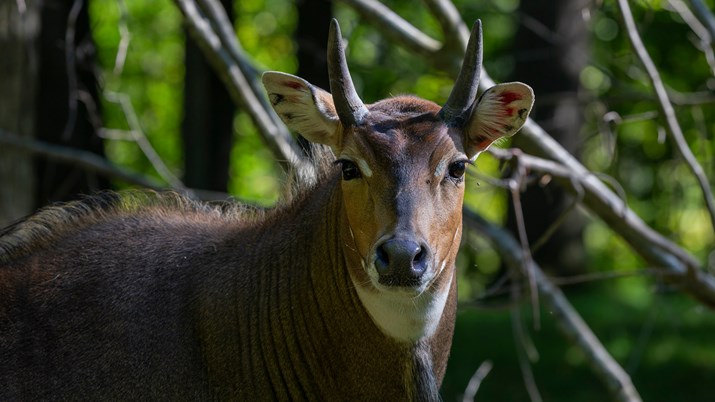
Nilgai are diurnal, or active mainly during the daylight hours. These antelopes travel in herds unless alarmed then they scatter to reassemble when the threat ceases. Cows tend to herd with other cows and young nilgai and bulls tend to herd with other adult bulls. Nilgai prefer low shrubs and grassy plains to thick wooded forest. South Texas is the ideal habitat for these large transplants.
SHEEP
Aoudad Sheep (Ammotragus Lervia)
Aoudad sheep are native to the arid and rugged mountains of Northern Africa. The Aoudad, also known as Barbary sheep, is a member of the subfamily, caprine of the Bovidae family which includes goats and sheep. Aoudad have horns that are curved and sweep backwards. Horns measuring 27 inches to 35 inches along the curve are considered trophies. Audad have long beards and shaggy chaps on their front legs. Because of this, hunters usually opt for a half mount to show off this impressive trophy animal.
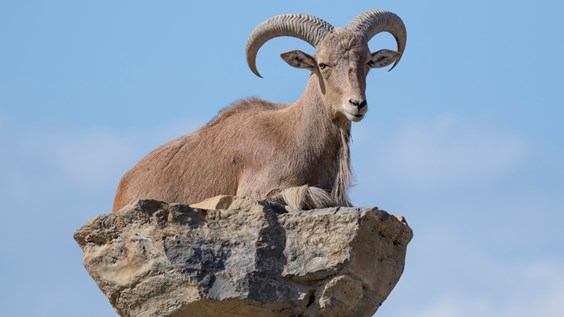
Hunting aoudad sheep can be very strenuous. They live in rocky, open areas that require the hunter to walk miles to get a shot. The hunter must be proficient in taking very long shots. When hunting audad, hunters seldom get the 100-yard shots that most whitetail hunters are used to.
Corsican Sheep (Ovis aries mouflon)
Corsican sheep are a hybrid cross developed in Texas in the 1970s. It is a cross between the mouflon sheep (Ovis gmelina) from the Caspian region and the Barbados blackbelly sheep (Ovis aries) from Barbados. These sheep can grow very impressive horns and beautiful coats.
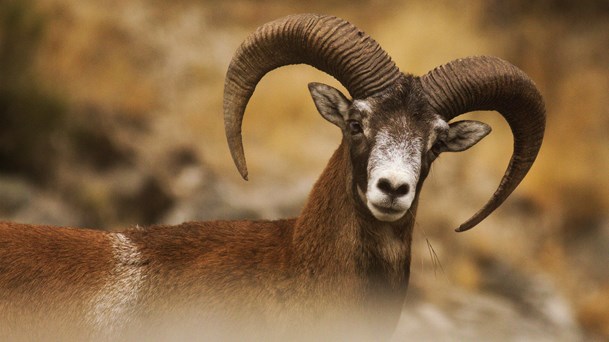
If you want, you can go for the Texas Corsican Grand Slam! There are 5 types of Corsican sheep: the common Corsican Sheep, Painted Desert Sheep, Texas Dall Sheep, Desert Sand Sheep, and Black Hawaiian Sheep.
